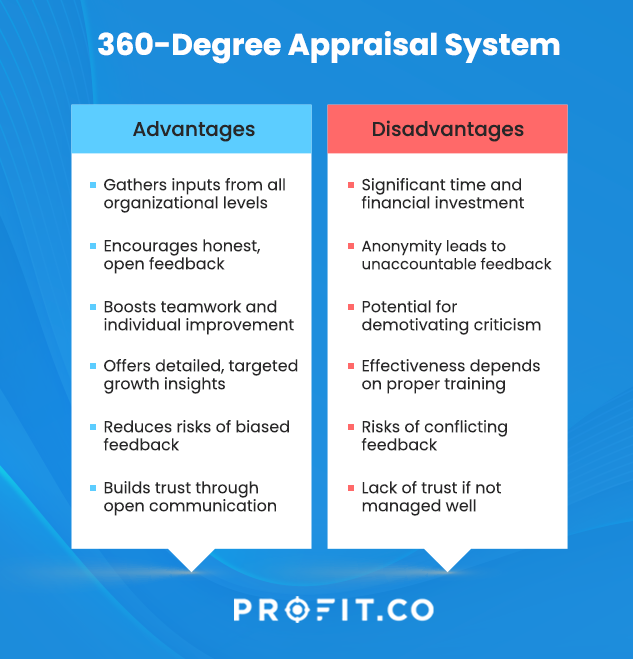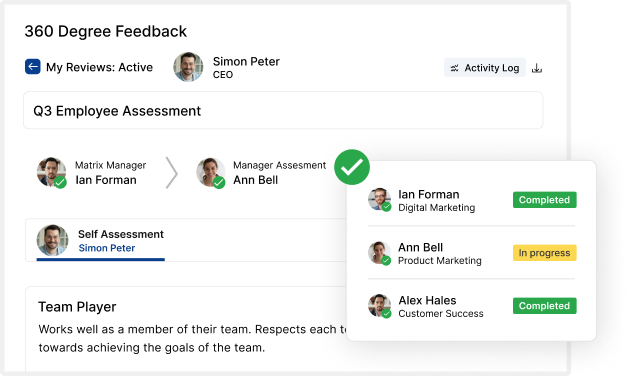What is a 360-degree Appraisal?
A 360-degree appraisal is a holistic approach to an employee review within a performance management system. It involved gathering the opinions of several members and interacting with the employees at work. Typically, this would be their manager, peers, and the employee’s own opinion of themself. It is a combination of traditional assessment, self-assessment, and peer assessment. The key idea is that it reduces the chance of biases and errors that you would get from simpler appraisals.
Once collected, it should give a detailed understanding of the employee’s strengths and weaknesses. In addition to better understanding how the employee is performing, it is useful to managers as they can decide how to guide the employee better. HR can also use the data to consider bonuses, pay raises, or promotions within the organization. A well-conducted review is essential for any organization as it assists in resource allocation and compensation.
Usually, it helps with:
- Skill Development: Seeing which areas need improvement for better leadership
- Potential Identification: Understanding which employees can contribute significantly
- Performance Appraisals: Seeing how well an employee accomplished their goals
- Training: How to best bridge gaps in skills and competencies
- Succession Planning: Seeing who is best suited to fill a position
The origin of the 360-degree feedback can be traced to the 1930s. Johann Baptist Reiffert, a military psychologist, developed it to help choose officer candidates. It entered the business world in the 1950s when the ESSO Research and Engineering Group, now ExxonMobile, utilized it. After their success with it, its popularity exploded and slowly expanded into the mainstream. Jack Welsh, CEO of General Electric, used it to justify firing the worst-performing 10% yearly. His use was more cutthroat than others who simply valued it as a tool to help employees grow. Now, 360-degree feedback is commonly known in HR departments and approximately a third of US companies use it.
Advantages and Disadvantages

Though popular, this type of appraisal has many advantages and disadvantages. It’s important to be familiar with them to see whether this methodology suits your business.
Advantages
Broader perspective
Information from multiple sources familiar to the employee can mean a more accurate understanding of them. It considers colleagues, superiors, subordinates, and even external stakeholders. With more information, employees can be more receptive and willing to take feedback on improving themselves. Imagine you’re a chef in a busy restaurant. Your performance isn’t just about how well you cook; it’s also about how you work with the waitstaff, manage your kitchen team, and handle customer feedback. A 360-degree appraisal is like getting reviews from the waiters, the sous-chef, and even the customers. This variety of viewpoints can help you see a more complete picture of how you’re doing and where you can improve.
Anonymity
Like most other appraisals, feedback is anonymous, so those rating the employee will feel comfortable sharing negative and constructive feedback. Think of it like those suggestion boxes in offices. People can drop in their honest thoughts without attaching their names. This way, your coworkers can freely share their insights, including the tough bits, without feeling awkward the next time they see you at the coffee machine.
Better engagement
Employees can be encouraged to work better with their colleagues and other employees within the company, knowing that their view of him or her can be important. If the 360-degree appraisal is the standard tool for the company, this standard applies to everybody.It’s like being part of a basketball team. Knowing that your teammates’ opinions matter in your appraisal makes you more likely to pass the ball, communicate better, and play a more collaborative game.
Reduced bias
If enough data is collected and then analyzed, it helps filter out biases and errors you would usually get from collecting from one source. A manager would not engage in the same way with an employee a peer would and could miss out on vital information. Ideally, it would enhance the fairness of the system. Picture a school where different teachers observe a student in various subjects and activities. This approach can paint a more accurate picture of the student’s strengths and weaknesses than if just one teacher gave all the feedback.
You got to be rigorous in your appraisal system. The biggest cowards are managers who don’t let people know where they stand.
Performance development
The more insight collected, the easier it will be to help the employee. A holistic view of how the employee performs can help managers and HR workers create detailed plans to best assist the employee in improving themselves. It’s like having a fitness coach, a dietitian, and a physiotherapist all giving you advice on improving your health. Each gives you insights from their expertise, helping you develop a well-rounded improvement plan.
Strategic assistance
If you collect information from all those an employee engages with on a day-to-day basis, you will gain an in-depth understanding of what kind of environment they best perform in. This makes re-structuring hierarchies efficient and informed. Consider a football coach who watches game tapes, listens to players, and gets input from assistant coaches. This comprehensive view helps the coach strategically decide player positions and game tactics.
Builds trust
A well-implemented 360-degree appraisal can provide a reliable and safe space for communication between employees and managers if they are encouraged to appreciate the feedback and not take it negatively. When done right, everyone feels safe to share their thoughts and feelings almost like a family meeting. This openness can build trust and improve relationships.
To learn how Profit.co’s digital solution can aid your company in removing bottlenecks
Disadvantages
Cost
As we mentioned before, this kind of appraisal combines other types. By that logic, the cost also adds up. It is not just in monetary terms either, as it takes time for one individual to get feedback from several people. It must also be conducted for many people frequently and at specific time intervals. Think of organizing a big event like a wedding. There’s not just the cost of the venue and food but also the time spent planning, coordinating with different people, and managing everything. A 360-degree appraisal can be similar in terms of both time and money investment.
Anonymity
This can also be a disadvantage, as anonymity can mean people won’t be held accountable for their comments. Good feedback is built from sincere and well-thought-out responses, so being anonymous could remove the motivation to do so. It’s a double-edged sword. Like online reviews, some people might be less thoughtful or constructive when they know they’re anonymous.
Negativity
While several perspectives can give a better picture, it also means there’s a chance of too much negative feedback. In this case, the appraisal is discouraging, which is the opposite effect intended. Imagine a social media post where people only focus on the negatives. A 360-degree appraisal can become a demoralizing flood of criticism rather than a helpful tool if not managed well.
Poor implementation
The success of 360-degree appraisal relies on it being introduced and taught well. Failure often stems from reviewers needing to be taught how to appropriately give feedback, in which case it becomes a waste of time and money. Rolling back to previous methods can confuse employees as well. It’s like a new software that everyone in the office should use, but no one knows how. Without proper training and understanding, it becomes more of a hassle than a helpful tool, and people might just want to go back to the old way of doing things.
Digital Solution
Though 360-degree appraisal has been around for several decades, recent technological innovations have taken this method to the next stage. The complexity of asking and recording several individuals’ feedback many times over is made easier through digital HR tools. Adopting such a tool requires consideration of cost and how it fits the company culture. In the long term, it saves time and money.
Profit.co’s Performance Management Software promotes transparency by providing real-time visibility into goals, progress, and metrics, fostering an unbiased review process, and cultivating an accountable organizational culture. The platform showcases graphical data visualizations representing employee information within the organization.

Conclusion
If you are in HR or have worked long enough, you would have heard of the 360-degree appraisal method. While it is extremely useful, it is first important to consider whether your business is at the stage where you can use it, and if not, how you can prepare the infrastructure for it in the future. That can be made easier through the use of digital solutions or by conducting workshops with professionals who are familiar with the topic. In the end, the benefits of it can help your employees grow personally and professionally.

